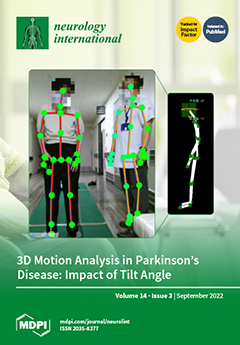Neurol. Int., Volume 14, Issue 3 (September 2022) – 19 articles
In patients with Parkinson’s disease, motor assessment is an important issue in evaluating disease progression or the efficacy of therapy. Based on the progresses of imaging capture, image processing and analyses, the quantified evaluation of postures and gaits is currently becoming increasingly popular. We used the AKIRA® system for three-dimensional evaluation of body movements of patients with Parkinson’s disease. The three-dimensional analysis of gait motion was compared with the MDS-UDPRS, and its usefulness as an evaluation index was examined. Results showed that the forward and side tilt angle of neck and trunk measured by AKIRAⓇ can be a candidate for a quantitative severity index in patients with PD. View this paper
- Issues are regarded as officially published after their release is announced to the table of contents alert mailing list.
- You may sign up for e-mail alerts to receive table of contents of newly released issues.
- PDF is the official format for papers published in both, html and pdf forms. To view the papers in pdf format, click on the "PDF Full-text" link, and use the free Adobe Reader to open them.






